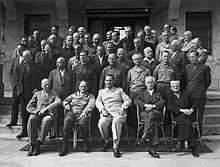Camp Ashcan

Central Continental Prisoner of War Enclosure No. 32, code-named Ashcan, was an Allied prisoner-of-war camp in the Palace Hotel of Mondorf-les-Bains, Luxembourg during World War II. Operating from May to August 1945, it served as a processing station and interrogation center for the 86 most prominent surviving Nazi leaders prior to their trial in Nuremberg, including Hermann Göring and Karl Dönitz.
A British counterpart of Ashcan, Camp Dustbin in Castle Kransberg near Frankfurt am Main, housed prisoners of a more technical inclination including Albert Speer and Wernher von Braun.
History

The camp was established by order of Allied Command.[1] It was commanded by U.S. Army Col. Burton C. Andrus, and staffed by men of the U.S. 391st Anti-Aircraft Battallion,[2] Allied intelligence services and 42 German prisoners of war selected for their skills, including a barber, dentist, doctor and even a hotel manager.[3]
The place selected for the camp was the Palace Hotel, a four-story luxury hotel dominating the small spa town, which had earlier in 1945 been used as a billet for U.S. troops.[1] The hotel was transformed into a high-security area with a fifteen-foot high electrified barbed wire fence, guard towers with machine guns and klieg lights.[4] Security was so tight that even the MPs guarding the perimeter knew not what went on inside; they quipped that getting in required "a pass signed by God, and then somebody has to verify the signature".[2] Conditions in the prison were Spartan. The hotel furniture was replaced by Army cots and collapsible tables.[3]
On 10 August 1945, the prisoners were transferred to Nuremberg to stand trial, and the camp was disbanded shortly afterwards. The building continued to serve as a hotel until 1988, when it was demolished to make way for a more modern spa.
Prisoners
Prisoners at Ashcan included most of the accused in the Nuremberg Trials and other senior Nazi dignitaries, such as:
- Reichsmarschall Hermann Göring
- Joachim von Ribbentrop, foreign minister
- Robert Ley, head of the German Labour Front
- Generalfeldmarschall Wilhelm Keitel, head of the Oberkommando der Wehrmacht
- Generaloberst Alfred Jodl
- Großadmiral Karl Dönitz
- Fritz Sauckel, General Plenipotentiary for Labour Deployment
- Walther Funk, minister of the Economy, president of the Reichsbank
- Hans Frank, General Governor of Poland
- Wilhelm Frick, minister of the Interior
- Arthur Seyß-Inquart, governor of the Netherlands
- Julius Streicher, publisher of Der Stürmer
- Johann Ludwig Graf Schwerin von Krosigk, minister of finance
- Generalfeldmarschall Gerd von Rundstedt
- Generalfeldmarschall Albert Kesselring
References
- Dolibois, John E. (2001). Pattern of Circles: An Ambassador's Story. Kent State University Press. ISBN 9780873387026.
- Galbraith, John Kenneth (22 October 1945). "The "Cure" at Mondorf Spa". LIFE. Retrieved 2009-10-30.
- Goda, Norman J. W. (2007). Tales from Spandau: Nazi criminals and the Cold War. Cambridge University Press. ISBN 9780521867207.
- Schnee, Philipp (28 October 2009). "Hotel der Kriegsverbrecher". einestages (in German) (Der Spiegel). Retrieved 2009-10-30.